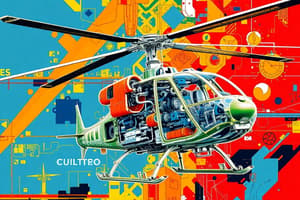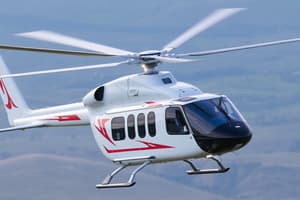Podcast
Questions and Answers
Which component of a helicopter is responsible for transmitting power from the engine to the main rotor?
Which component of a helicopter is responsible for transmitting power from the engine to the main rotor?
- Airframe
- Landing gear
- Transmission (correct)
- Cabin
What is the purpose of the antitorque system in a helicopter?
What is the purpose of the antitorque system in a helicopter?
- To provide aerodynamic forces for flight
- To house the various components
- To prevent the helicopter from turning due to torque (correct)
- To carry the payload and crew
What are the three classifications of a rotor system in a helicopter?
What are the three classifications of a rotor system in a helicopter?
- Cabin, airframe, landing gear
- Single main rotor, dual rotor
- Fully articulated, semirigid, rigid (correct)
- Flapping, feathering, leading or lagging
Which flight control is responsible for controlling the pitch of the main rotor blades?
Which flight control is responsible for controlling the pitch of the main rotor blades?
Which engine type is commonly used in medium to heavy lift helicopters?
Which engine type is commonly used in medium to heavy lift helicopters?
What are the four basic flight controls used when flying a helicopter?
What are the four basic flight controls used when flying a helicopter?
Which type of rotor system allows for two different movements, flapping and feathering?
Which type of rotor system allows for two different movements, flapping and feathering?
Which type of rotor system is mechanically simple, but structurally complex because operating loads must be absorbed in bending rather than through hinges?
Which type of rotor system is mechanically simple, but structurally complex because operating loads must be absorbed in bending rather than through hinges?
What is the purpose of the antitorque rotor or tail rotor in a helicopter?
What is the purpose of the antitorque rotor or tail rotor in a helicopter?
What is the NOTAR® system in a helicopter?
What is the NOTAR® system in a helicopter?
True or false: The gas turbine engine is used in most light lift helicopters.
True or false: The gas turbine engine is used in most light lift helicopters.
True or false: The throttle control is located on the end of the cyclic pitch control.
True or false: The throttle control is located on the end of the cyclic pitch control.
True or false: The collective pitch control controls the pitch of the tail rotor.
True or false: The collective pitch control controls the pitch of the tail rotor.
Another engine type used in most medium to heavy lift helicopters due to its large horsepower output is the gas ______.
Another engine type used in most medium to heavy lift helicopters due to its large horsepower output is the gas ______.
The throttle, which is usually a twist grip control located on the end of the collective lever, controls the ______ of the main rotor blades.
The throttle, which is usually a twist grip control located on the end of the collective lever, controls the ______ of the main rotor blades.
The gas turbine engine drives the main ______, which then transfers power directly to the main rotor system, as well as the tail rotor.
The gas turbine engine drives the main ______, which then transfers power directly to the main rotor system, as well as the tail rotor.
Flashcards are hidden until you start studying
Study Notes
Helicopter Power Transmission
- The transmission system connects the engine to the main rotor, enabling power transfer necessary for flight.
Antitorque System Purpose
- The antitorque system, commonly the tail rotor, counteracts the torque effect produced by the main rotor, stabilizing the helicopter's yaw movement.
Rotor System Classifications
- Three primary classifications of rotor systems:
- Conventional: Single main rotor with a tail rotor.
- Tandem: Two main rotors in tandem configuration.
- Intermeshing: Two main rotors that intersect, eliminating the need for a tail rotor.
Pitch Control
- The collective control manages the pitch angle of the main rotor blades, allowing for altitude adjustments.
Engine Types for Heavy Lift Helicopters
- Turboshaft engines are frequently utilized in medium to heavy lift helicopters due to their efficiency and power.
Basic Flight Controls
- Four essential flight controls for helicopter operation include:
- Cyclic Pitch Control: Affects rotor blade pitch to change direction.
- Collective Pitch Control: Adjusts overall rotor blade pitch for altitude changes.
- Antitorque Pedals: Control the tail rotor's pitch for yaw movements.
- Throttle Control: Regulates engine power output.
Rotor System Movements
- The semi-rigid rotor system allows for both flapping and feathering movements, enhancing performance and control.
Structural Complexity
- The fully articulated rotor system, while mechanically straightforward, is structurally complex as it absorbs loads through bending rather than hinges.
Antitorque Rotor Purpose
- The tail rotor (antitorque rotor) generates thrust in the opposite direction of the main rotor's torque, maintaining helicopter stability and control.
NOTAR® System
- The NOTAR® (No Tail Rotor) system uses a fan-driven technology to produce thrust, eliminating the need for a tail rotor and improving safety and efficiency.
Engine Types (True/False)
- True: Gas turbine engines are prevalent in most light lift helicopters.
- False: The throttle control is typically found on the collective lever, not at the end of the cyclic pitch control.
- False: The collective pitch control does not manage the tail rotor's pitch; it solely adjusts the main rotor's pitch.
Gas Engine Type
- The gas turbine engine is another type commonly found in medium to heavy lift helicopters, known for its high horsepower output.
Throttle Control Location
- The throttle control, usually in the form of a twist grip on the collective lever, adjusts the power of the main rotor blades.
Main Rotor System Connection
- The gas turbine engine drives the main transmission, which subsequently transfers power to both the main rotor system and the tail rotor.
Studying That Suits You
Use AI to generate personalized quizzes and flashcards to suit your learning preferences.



